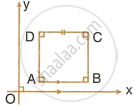Advertisements
Advertisements
प्रश्न
Without using the distance formula, show that the points A(4, −2), B(−4, 4) and C(10, 6) are the vertices of a right-angled triangle.
उत्तर
The given points are A(4, −2), B(−4, 4) and C(10, 6).
Slope of AB = `(4 + 2)/(-4 - 4)`
Slope of AB = `6/(-8)`
Slope of AB = `(-3)/4` ...(1)
Slope of BC = `(6 - 4)/(10 + 4)`
Slope of BC = `2/14`
Slope of BC = `1/7` ...(2)
Slope of AC = `(6 + 2)/(10 - 4)`
Slope of AC = `8/6`
Slope of AC = `4/3` ...(3)
From (1) and (3)
It can be seen that:
Slope of AB = `(-1)/"Slope of AC"`
Hence, AB ⊥ AC
Thus, the given points are the vertices of a right-angled triangle.
APPEARS IN
संबंधित प्रश्न
The side AB of a square ABCD is parallel to the x-axis. Find the slopes of all its sides. Also, find:
- the slope of the diagonal AC.
- the slope of the diagonal BD.

Find the slope and the inclination of the line AB if : A = `(-1, 2sqrt(3))` and B = `(-2, sqrt(3))`
Lines 2x – by + 5 = 0 and ax + 3y = 2 are parallel to each other. Find the relation connecting a and b.
Find the type of the quadrilateral if points A(–4, –2), B(–3, –7) C(3, –2) and D(2, 3) are joined serially.
Find the slope of the diagonals of a quadrilateral with vertices A(1, 7), B(6, 3), C(0, –3) and D(–3, 3).
Find the slope and the y-intercept of the following line 4y = 5x - 8
Verify whether the following points are collinear or not:
A(1, –3), B(2, –5), C(–4, 7).
Write the equation of a line passing through the point P (0,6) and having slope 6/7.
Find the slope of the line passing through given points G(3, 7) and K(–2, –3).
What is the name of the point of intersection of coordinate axes?
